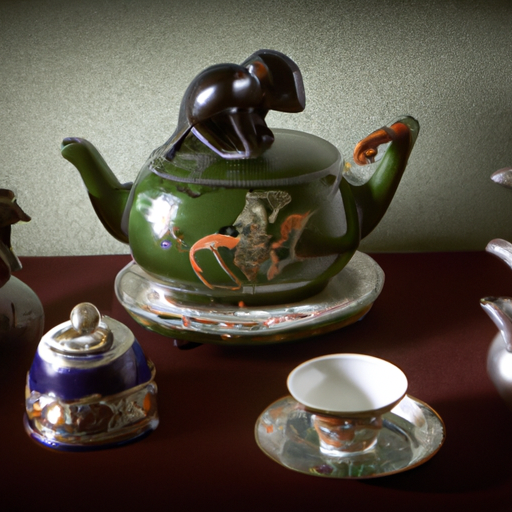The Timeless Allure of Tea Pets: Nurturing Traditions and Personal Collections
The tea-sippers of ancient China have sipped, chatted and pondered for millennia. As these tea lovers sought contemplation and deep connection to their brew, they nestled symbols, artwork, and items of meaning into their tea rituals. One such curious item, often perched on the tea table of ancient tea aficionados, was the little tea pet. In this post, we'll delve into the cuddly – or, shall we say, steeped – world of tea pets; let's spritz, sip and cherish these little creatures.
What are Tea Pets?
Tea pets (茶宠), charming miniature sculptures adorning many a tea lover's table, have been an essential part of the Chinese tea ceremony for centuries. These artful companions, traditionally made from yixing clay or porcelain, are believed to bring good luck and happiness to their caretakers, and often used to represent the owner's individualism.
Teahouses and tea enthusiasts sprinkle these figurines with tea, ensuring they absorb the aroma and essence of the brew. Over time, these sprinklings give the tea pet a unique patina, a color that reflects not just the teas consumed but the memories made and cherished during countless tea sessions.
Origins and Symbolism
The birth of tea pets can be traced back to the Ming dynasty (1368-1644), a deeply artistic era in the history of China. Such creative expression extended to the craft of tea, as it began to incorporate a variety of teas and embellishments like tea utensils, tea tables, and tea pets.
The tea pets acquire a symbolic significance, such as ensuring good fortune, promoting peace, and warding off evil. Some popular tea pet designs are:
| Tea Pet | Symbolic Meaning |
|---|---|
| Pixiu | Wealth and fortune-keeper |
| Buddha | Blessings and protection |
| Dragon | Strength and power |
| Toad | Prosperity and wealth |
| Fish | Abundance and good luck |
| Rabbit | Fertility and creativity |
Craft and Care
Tea pets are typically fashioned from unglazed yixing clay, a material renowned for its distinct reddish-brown color, porous nature, and natural minerals. The same yixing clay (宜兴泥) used for making traditional Yixing teapots is also used in the crafting of the tea pets because it helps the pets develop their patina more effectively.
Moreover, the natural porous nature of the clay is said to improve the taste and aroma of the tea, making it a favored choice among tea enthusiasts. The clay is sourced from the Jiangsu province of China, and the skills in preparing yixing clay have been honed and passed down from generation to generation.
To nurture your own tea pet, follow these simple steps:
- Clean your tea pet with clean water before use and avoid soap, as it may be absorbed and negatively impact the tea.
- Place your tea pet on a tea table or tray, and periodically pour some hot water over it to 'rinse' it for a few weeks.
- During tea sessions, sprinkle tea or rinse water (the first wash of the leaves) onto the pet to maintain and develop the patina.
- Gently rub the pet with a soft cloth after each session.
- Avoid abrasive cleaning methods or chemicals, as this can strip away the pet's patina and damage its charm.
Building Your Tea Pet Collection
People new to the world of tea pets may find it hard to know where to start when building their collection. Here are some tips to help you on your tea pet journey:
- Begin with a simple, single tea pet that represents your personality and aspirations.
- Learn about the various tea pets, their symbolism, and their history.
- Examine the craftsmanship and detailed work of the tea pet, ensuring it is of high quality.
- Expand your collection with other tea pets that represent your growing interests, teas, or meaningful symbols.
- Gift tea pets to close friends and family to share the joy and warmth that these figurines bring to tea sessions.
The Tea Pets in Modern Culture
Despite their ancient origins, tea pets have remained a popular part of tea culture, evolving and adapting with modern practices. Today, tea pets are crafted in various materials, such as glazed ceramics, porcelain, and even glass. They are available in diffusing materials and modern designs, catering to a broader audience and growing in demand across the globe.
These little tokens of culture and personal companions now grace many a tea table – whether steeped in tradition or of contemporary design. Tea pets offer a joyful friendliness and unwavering loyalty as they serve as silent listeners to the tea-sippers deep in conversation, mending old ties or forging new bonds. Tea pets are more than just decorations; they're links to ancient Chinese tea rituals, and the spirit and the warmth of camaraderie. So, next time you steep your favorite tea, spare a thought (and perhaps a splash) to the humble tea pet, a steadfast companion to tea drinkers for centuries.
Have you discovered the joy of tea pets yet? Share your thoughts on these miniature mascots in the discussion area below, and join in the conversation with fellow tea enthusiasts about the magic these little creatures bring to your tea sessions.
